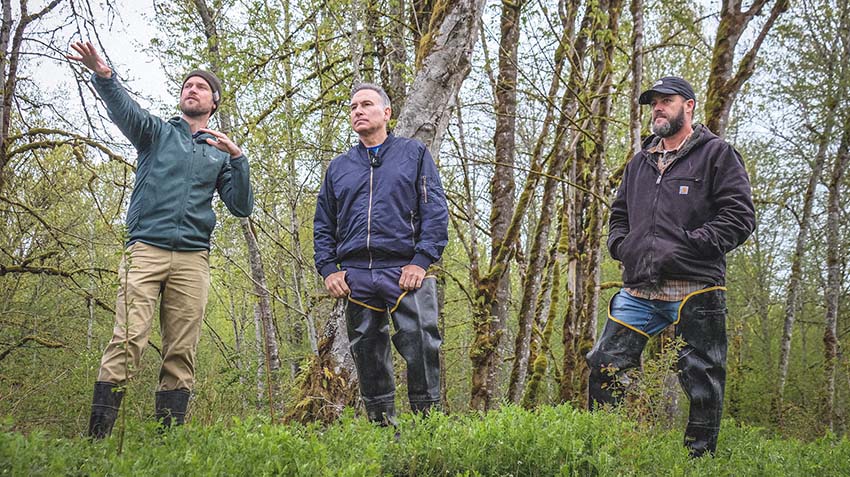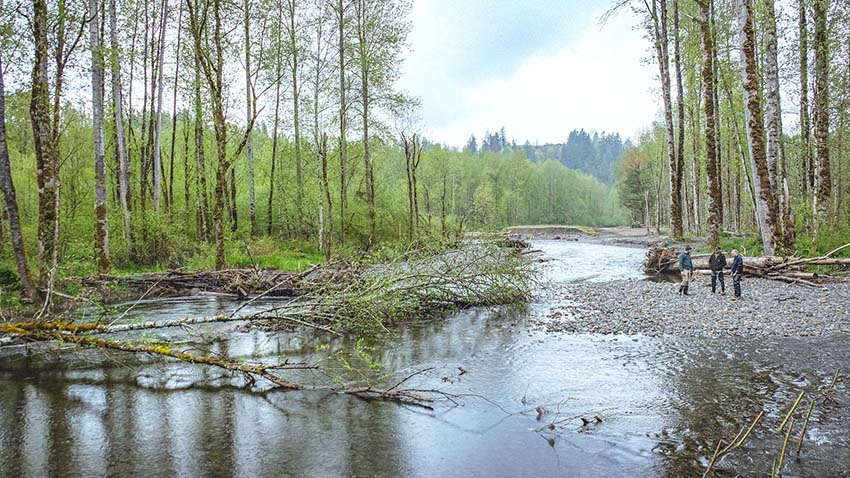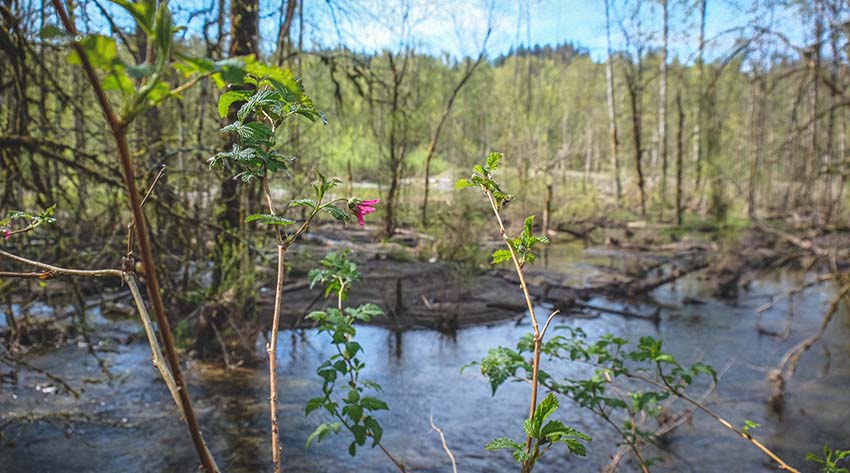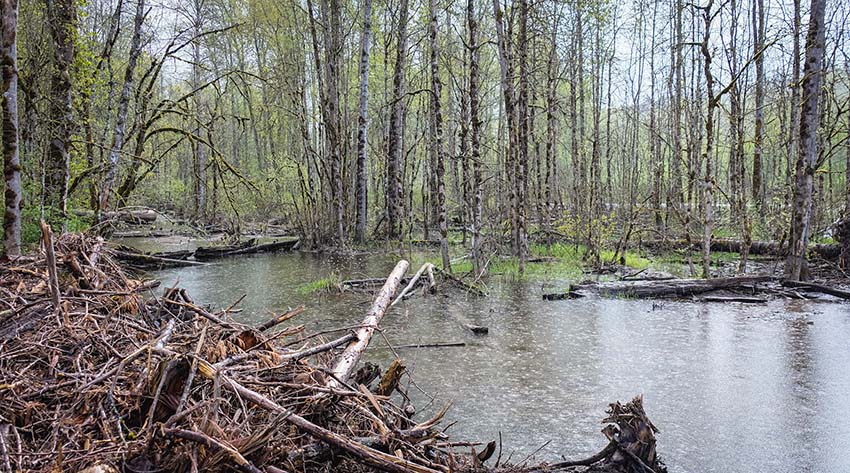A major King County restoration project along the Green River is improving salmon habitat, protecting homes, farms, and roads from flooding
Summary
A successful floodplain restoration project along the Green River near Auburn is improving habitat for fish and wildlife while also protecting farms and homes from flooding and erosion. It now provides greater diversity of habitat for native salmon that provide sustenance for Puget Sound orcas.
Story
King County Executive Dow Constantine today congratulated staff and partners for completing a major restoration project along the Green River that has improved fish and wildlife habitat while protecting nearby farmland, homes, and roads from flooding and erosion.
The successful project near Auburn replaced the degraded Lones Levee, which was built in the 1960s, with a modern, integrated design that restores a critical section of the Green River to a more natural state. The site will now be known by its traditional Lushootseed name, čakwab, pronounced “chock-wob," as identified by the Muckleshoot Indian Tribe. The name was applied to this place by Tribal ancestors to mean “bring something to the water.”
It is one of the largest capital projects ever conducted along the Green River, which flows into Puget Sound as the Duwamish River. It will increase the quantity and diversity of habitat for native salmon that provide sustenance for southern resident orcas.
“Our staff and partners have completed one of the biggest restoration projects ever attempted along the Green River, an achievement that will improve salmon habitat, provide more food for Puget Sound orca, and protect homes, farms, and roads from flooding and erosion,” said Executive Constantine. "Throughout King County, we are restoring watersheds to a more natural state for the benefit of all living things that call this spectacular place home.”
Crews created three side channels that provide juvenile salmon with the ideal habitat they need to rest, rear, and hide from predators, increasing their odds of surviving the journey to the Pacific Ocean and returning as adults to spawn.
They also installed engineered logjams to replicate the positive effects of trees and other wood debris that traditionally fell into the river before the surrounding area was altered for farming and other uses. The engineered logjams recreate complex natural structures that provide juvenile salmon with slower, meandering side channels where they can reach their ideal size before migrating downstream.
Large-scale, complex capital projects in developed watersheds typically take at least a decade to complete, but King County and its partners completed this project in just six years, from design to completion.
A contributing factor to the success was unifying the efforts of multiple agencies, nonprofits, and private landowners to achieve mutually beneficial goals. King County’s Water and Land Resources Division is the lead agency, coordinating with the Green/Duwamish and Central Puget Sound Watershed, known as WRIA 9, and the King County Flood Control District.
"The Lones Levee project is a great example of multiple partners coming together on the Green River to create a better environment for our salmon while still ensuring residents and properties are protected from flooding," said King County Flood Control Chair Dave Upthegrove, who is also a King County Councilmember. "This type of collaboration should be our goal as we work to improve conditions in the Green for future generations."
Highlights of the project include:
- Removing the old, damaged 1,600-foot-long levee
- Removing more than 25,000 cubic yards of rock and soil
- Building a 1,500-foot-long facility that protects nearby farmland and homes from erosion and flooding
- Building three new side channels that divert water out of the main river channel to engage the floodplain and add complexity
- Building a 1,900-foot-long gravel road for maintenance crews
Restoring King County watersheds to their natural state
The Green River is one of the top three most productive salmon streams in the Puget Sound region, thanks in part to actions that King County and partners have taken over the past 20 years. But the habitat in the middle section of the Green River was degraded during the second half of the 20th century as the result of landscape changes, including dam construction, fewer trees upstream falling into the river to add complexity, and levees that constricted the river, reducing and damaging habitat for juvenile salmon.
King County acquired 41 acres for the $6.2 million project in 2018, primarily with funds generated by Conservation Futures. It is part of the Land Conservation Initiative, a regional partnership Executive Constantine launched in 2016 to protect 65,000 acres of the highest conservation-value open space in King County within a single generation.
It is the latest in a series of projects led by King County and partners to restore watersheds to their natural state to achieve multiple benefits, advancing Executive Constantine’s Clean Water Healthy Habitat initiative to produce better results faster for people, salmon, and orcas.
Relevant links
- VIDEO: Restoring habitat, reducing flood risks on the Green River
- VIDEO: A major restoration project along the Green River
- PHOTO GALLERY: Celebrating the completion of the restoration project
- VIDEO: B-roll package available for download
- Project overview
- Clean Water Healthy Habitat
- Tracks: An interactive map tracking progress on environmental stewardship
Quotes
Our staff and partners have completed one of the biggest restoration projects ever attempted along the Green River, an achievement that will improve salmon habitat, provide more food for Puget Sound orca, and protect homes, farms, and roads from flooding and erosion. Throughout King County, we are restoring watersheds to a more natural state for the benefit of all living things that call this spectacular place home.
The Lones Levee project is a great example of multiple partners coming together on the Green River to create a better environment for our salmon while still ensuring residents and properties are protected from flooding. This type of collaboration should be our goal as we work to improve conditions in the Green for future generations.
For more information, contact:
Doug Williams, Department of Natural Resources and Parks, 206-477-4543

 Translate
Translate



